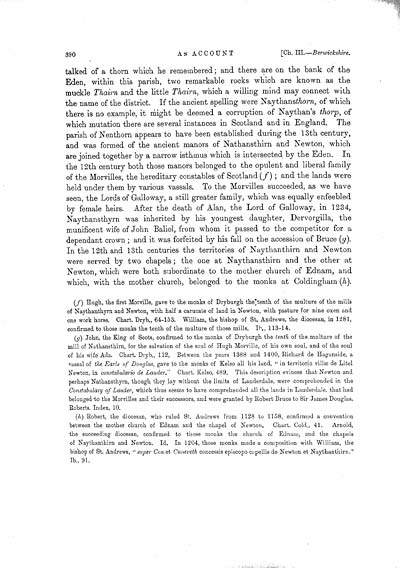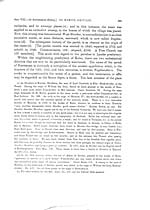Volume 3
(402) Page 390
Download files
Individual page:
Thumbnail gallery: Grid view | List view

390 talked of a thorn which he remembered; and there are on the bank of the Eden, within this parish, two remarkable rocks which are known as the muckle Thairn and the little Thairn, which a willing mind may connect with the name of the district. If the ancient spelling were Naythansthorn, of which there is no example, it might be deemed a corruption of Naythan's thorp, of which mutation there are several instances in Scotland and in England. The parish of Nenthorn appears to have been established during the 13th century, and was formed of the ancient manors of Nathansthirn and Newton, which are joined together by a narrow isthmus which is intersected by the Eden. In the 12th century both those manors belonged to the opulent and liberal family of the Morvilles, the hereditary constables of Scotland (f); and the lands were held under them by various vassals. To the Morvilles succeeded, as we have seen, the Lords of Galloway, a still greater family, which was equally enfeebled by female heirs. After the death of Alan, the Lord of Galloway, in 1234, Naythansthyrn was inherited by his youngest daughter, Dervorgilla, the munificent wife of John Baliol, from whom it passed to the competitor for a dependant crown ; and it was forfeited by his fall on the accession of Bruce (g). In the 12th and 13th centuries the territories of Naythanthirn and Newton were served by two chapels; the one at Naythansthirn and the other at Newton, which were both subordinate to the mother church of Ednam, and which, with the mother church, belonged to the monks at Coldingham (h). (/) Hugh, the first Morville, gave to the monks of Dryburgh the tenth of the multure of the mills of Naythanthyrn and Newton, with half a carucate of land in Newton, with pasture for nine oxen and one work horse. Chart. Dryb., 64-153. William, the bishop of St. Andrews, the diocesan, in 1281, confirmed to those monks the tenth of the multure of those mills. Ib,, 113-14. (g) John, the King of Scots, confirmed to the monks of Dryburgh the tenth of the multure of the mill of Nathansthirn, for the salvation of the soul of Hugh Morville, of his own soul, and of the soul of his wife Ada. Chart. Dryb., 112. Between the years 1388 and 1400, Richard de Haganside, a vassal of the Earls of Douglas, gave to the monks of Kelso all his land, " in territorio vill� de Litel Newton, in constabulario de Lauder," Chart. Kelso, 489. This description evinces that Newton and perhaps Nathansthyrn, though they lay without the limits of Lauderdale, were comprehended in the Constabulary of Lander, which thus seems to have comprehended all the lands in Lauderdale. that had belonged to the Morvilles and their successors, and were granted by Robert Bruce to Sir James Douglas. Roberts. Index, 10. (h) Robert, the diocesan, who ruled St. Andrews from 1128 to 1158, confirmed a convention between the mother church of Ednam and the chapel of Newton. Chart. Cold., 41. Arnold, the succeeding diocesan, confirmed to those monks the church of Ednam, and the chapels of Naythanthirn and Newton. Id. In 1204, those monks made a composition with William, the bishop of St. Andrews, " super Con et Cuneveth concessis episcopo cupellis de Newton et Naythanthirn." Ib., 91.
Set display mode to:
![]() Universal Viewer |
Universal Viewer | ![]() Mirador |
Large image | Transcription
Mirador |
Large image | Transcription
Images and transcriptions on this page, including medium image downloads, may be used under the Creative Commons Attribution 4.0 International Licence unless otherwise stated. ![]()
| Caledonia, or, An account, historical and topographic of North Britain from the most ancient to the present times > Volume 3 > (402) Page 390 |
|---|
| Permanent URL | https://digital.nls.uk/74528878 |
|---|---|
| Description | Vol. III. |
|---|---|
| Attribution and copyright: |
|

